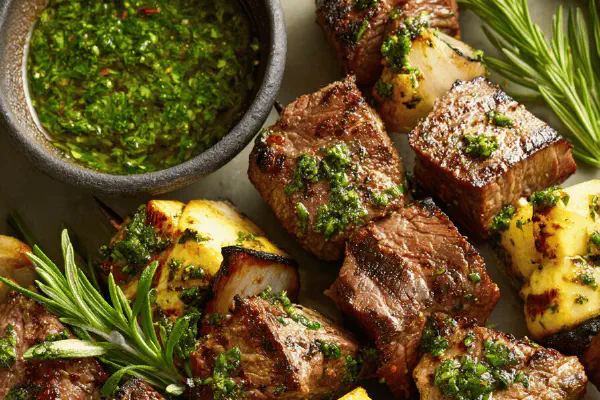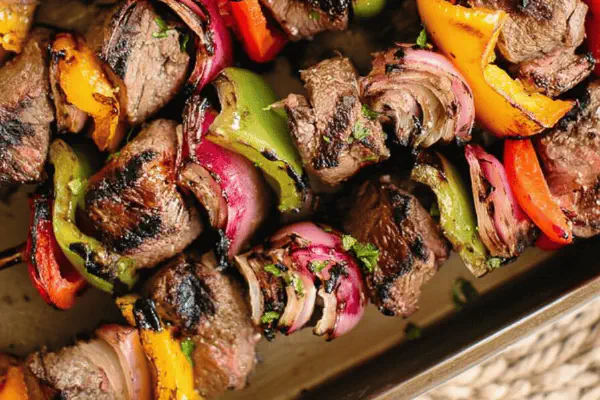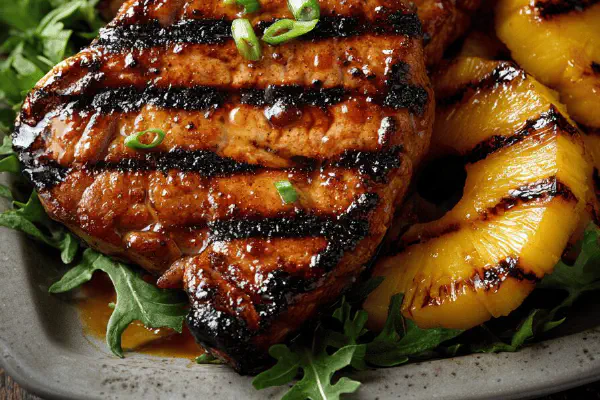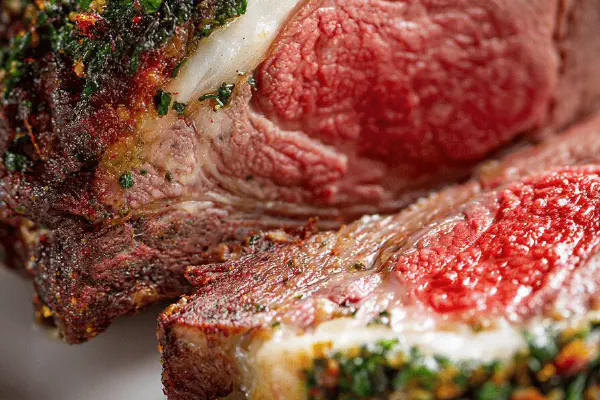Herbed Pork Beef Skewers

By Emma
Certified Culinary Professional
Ingredients
Herb Salt
- 10 ml (2 tsp) coriander seeds
- 5 ml (1 tsp) dried sage
- 5 ml (1 tsp) dried thyme
- 50 ml (3 tbsp) coarse sea salt
Skewers
- 1 small pork tenderloin (~350 g), cubed
- 350 g beef sirloin, cubed
- 4 wooden skewers, soaked 40 minutes or metal alternatives
About the ingredients
Method
Herb Salt
- 1. Toast coriander seeds lightly in a dry pan until fragrant but not burnt—about 1-2 minutes. Let cool slightly. Using a mortar and pestle or spice grinder, coarsely crush coriander, sage, and thyme. Add coarse salt and mix. Ditch the super fine ideas; rough crystals stick better to meat and create a caramelized crust.
Skewers
- 2. Fire up grill to high. Serious heat here—smoke wisps tell you it’s ready. Brush the grate lightly with oil to sidestep meat sticking.
- 3. Alternate pork and beef cubes on skewers. Don’t crowd; let each piece touch heat directly. Sprinkle herb salt evenly over skewers while they rest a minute but before grilling. Follow the scent—earthy sage with that warm coriander punch is heady.
- 4. Grill skewers 4-5 minutes per side. The sizzle changes from sharp to mellow as sugars caramelize and meat firms but stays springy. Look for grill marks, gentle crust forming. Press meat lightly with tongs; juicy bounce means medium rare. Over 10 min total, risk drying pork out—better safe to test earlier and adjust.
- 5. Rest skewers 3 minutes off heat under foil. Internal juices redistribute. Don’t skip rest or end with dryness. Meat feels warmer, smells deep, and surfaces soften slightly.
- 6. Serve straight on platter. The coarse salt bits add crunch, herbs perfume the air. If charred too far, flip duration or lower grill next time. Flame flare-ups? Shift skewers slightly away from direct heat.
Cooking tips
Chef's notes
- 💡 Toast coriander seeds lightly; watch closely—darkness creeps fast and bitterness kicks in. Coarse salt clings better; fine salt melts too fast, dries meat surface. Use mortar and pestle for chunky texture. That rough texture lets some crystals caramelize, adds crunch. Mixing fresh ground thyme with sage shifts flavor balance from piney to woodsy. Skip rosemary or reduce it drastically—past tries turned harsh.
- 💡 High heat grilling demands attention. Don’t overload skewers; pieces need space to sear not steam. Char marks tell part of story; paired with scent—smoke plus herb aroma—not to mention sizzle tone shifts. First aggressive hiss softens into mellow pop; that’s crust setting up. Flip once only. Too much fiddling breaks formed crust and releases juices prematurely.
- 💡 Press meat lightly to test doneness. Soft, squishy means rare inside, too firm means meat’s on its way to dryness. Bounceback feels like pressing ball, springy and yielding. Rest under foil off direct heat mandatory. Juices redistribute, surface softens slightly so your bite won’t dry out. Meat temperature keeps rising; resting counts as cooking too. Skewers soak prevents burnt wood taste and sudden flare-ups; metal alternatives heat fast but no soaking needed.
- 💡 Flare-ups inevitable with fatty beef or pork cuts. Shift skewers sideways or raise grill rack if flames surge. Don’t panic and thrash meat around. Grill oil lightly before cooking to reduce sticking but avoid pouring oil directly on skewers or flames will roar. If herbs unavailable, try fennel seed or smoked paprika for different notes but reduce salt-to-herb ratio; can overpower. Salt type matters—kosher works fine; avoid fine table salt for coarse crust effect.
- 💡 Keep in mind meat quality. Pork tenderloin best; lean and tender, avoids chewy patches. Beef sirloin or ribeye cubes hold moisture better than cheaper cuts that get grainy. Cubed size uniformity matters for consistent cook. Watch the aromas as well—sharp coriander nuttiness mixed with sage’s woodiness hits the nose before grill marks appear. Grill time roughly 4-5 minutes per side but watch closely. Over 10 minutes total dries pork. Rest 3 minutes minimum to seal in juiciness.
Common questions
How to tell when skewers are medium rare?
Use touch; press meat with tongs, should bounce back firm but springy. Watch sizzle shift—hiss to mellow pop. Visual grill marks and gentle crust form. Smell moves from sharp to sweet caramel. Avoid relying on timers only; meats cook fast over high heat.
What if I don’t have coriander seeds?
Ground cumin works but cut amount in half. Toast cumin lightly too or it can overwhelm quickly. Herbs like fennel or smoked paprika change profile but keep salt coarse. Fresh thyme or sage substitutes fine. Avoid fine salt; salt texture affects crust and juiciness retention.
How to manage flare-ups?
Move skewers sideways from direct flame fast. Grill oil grate lightly to reduce sticking and fat burns. Metal skewers reduce fire risk but heat quicker—hold steady tongs. Leave flare-up spot quickly; let grill cool or raise rack temporarily. Don’t press meat while flames roar or juices escape.
Can leftovers be saved well?
Reheat quickly on grill or pan to avoid drying out. Wrap loosely in foil when stored. Keep in fridge up to 2 days max. Skewers can lose texture if microwaved slow. Rest leftovers before eating. No soggy crust is key.



